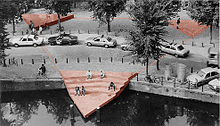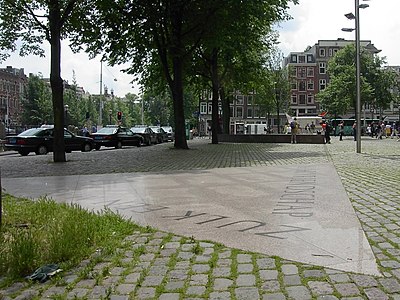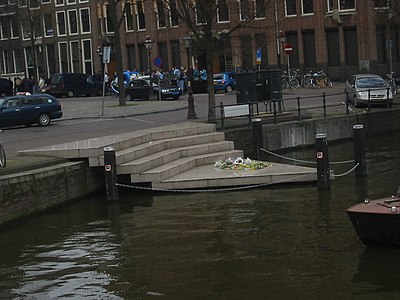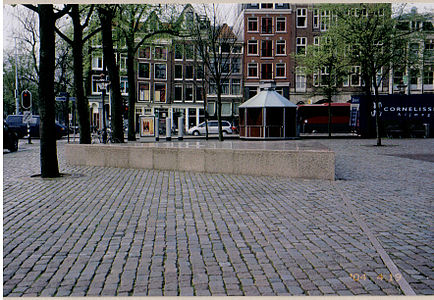Homomonument
 View from above | |
 Location in Amsterdam | |
| Coordinates | 52°22′28″N 04°53′05.5″E / 52.37444°N 4.884861°ECoordinates: 52°22′28″N 04°53′05.5″E / 52.37444°N 4.884861°E |
|---|---|
| Location | Amsterdam, Netherlands |
| Designer | Karin Daan |
| Material | granite |
| Completion date | 5 September 1987 |
The Homomonument is a memorial in the centre of Amsterdam, the capital of the Netherlands. It commemorates all gay men and lesbians who have been subjected to persecution because of their sexual orientation.[1] Opened on 5 September 1987, it takes the form of three large pink triangles made of granite, set into the ground so as to form a larger triangle, on the bank of the Keizersgracht canal, near the historic Westerkerk church. The Homomonument was designed to "inspire and support lesbians and gays in their struggle against denial, oppression and discrimination." It was the first monument in the world to commemorate gays and lesbians who were killed by the Nazis.[2]
During the Netherlands' annual Remembrance Day ceremony on 4 May, wreaths are laid on the monument to commemorate LGBT victims of persecution. A day later, on Liberation Day, the monument becomes the site of a street party.[3]
Symbolism[]
Homomonument is an abstract composition of three pink triangles made of granite. The symbol has historical roots - the pink triangle was a cloth badge used in Nazi concentration camps to identify men who had been jailed for homosexuality, which also included bisexual men and transgender women.[4] It is estimated that 100,000 men were arrested and half of these spent time in prison during the Nazi rule.[5] Subsequently, the pink triangle became a symbol of the emancipation of the LGBT community and its struggle for their rights.[6]
However, the Homomonument doesn't only commemorate the victims of World War II, but all homosexual men and women who were persecuted and murdered.[7][8] The monument also honours those who have struggled for freedom and the human rights of LGBTQ members.[9] The author of the monument, artist Karin Daan, described the symbolism of the monument like this:[7]
I think the best part is that the monument integrates itself into the place like an embroidery, and from above it is clearly visible how the triangle is intertwined with the urban and social space, that, for example, when taxi drivers stand in the middle of the monument, they are hardly aware of it. I think that is the most beautiful component of the Homomonument: we are there, proud and strong as granite, the monument binds us together here and now, but we are just as intertwined with the city and society in a larger time and space.
History[]


The idea of perpetuating the memory of homosexual victims of World War II appeared at the very beginning of the organized Dutch gay movement. In 1961 activist Jef Last suggested the idea of a 'monument to the unknown gay': "No one knows how many there were, no statistics indicate how many of them were beaten to death in those camps or starved or otherwise succumbed. No flame burns for unknown homophiles".[7] However, this idea did not gain practical development until the 1970s, when the visibility and openness of the marginalized and stigmatized gay community became important political goals for many gay rights organizations.[8]
In 1970 (a year before the complete decriminalization of homosexuality in the Netherlands),[10] a group of gay activists were arrested for trying to lay a wreath at the National Monument to the Victims of World War II on Dam Square, Amsterdam. The flowers were removed from the memorial by the police and declared insulting the memory of the dead. This incident caused anger among the LGBT community and served as an impetus for the development of the struggle for the recognition of victims of repression. Throughout the 1970s, similar wreath-placing demonstrations were executed with varying success, as activists constantly pushed for the inclusion of homosexuals in the public's collective memory of Hitler's "social purification" campaigns.[8]
In the spring of 1979, during a period of rapid development of gay emancipation, the initiative to build a monument to persecuted homosexuals entered a qualitatively new stage—the Homomonument Foundation was founded, the main goal of which was the implementation of the memorial project.[11] One of the founders of the fund was Pacifist Socialist Party member Bob van Schijndel. Pointing to the fact that in 1978 a monument to the Romani victims of the Nazi genocide was opened in Amsterdam, van Schijndel proposed a similar memorial which would be dedicated to the homosexuals who suffered during the Nazi rule.[7] The founders of the fund also included representatives of the Labour Party, the People's Party and the Christian Democratic Party of the Netherlands.[12]
In 1980 artists were invited to submit designs and a jury was assembled consisting of experts in the fields of art and design. 137 designs were submitted to the competition and in 1981, the jury chose the design by Karin Daan.[2] With the triangle on the water as its central point, Daan expanded the design to make her work as monumental as possible without disrupting the surroundings. The government of Amsterdam allocated a place for the construction of the monument, but the construction work took 8 years. Many organizations and individuals made donations to the construction, with individual contributions from the Dutch Parliament, the government of Ruud Lubbers, the city of Amsterdam and the province of North Holland.[13]
The idea of creating a monument was sharply criticized by a number of political and public figures who either did not recognize the very fact of repression, considering the persecution of homosexuals to be legal or argued their position by saying that the creation of a monument to a separate small group is irrational. Former Foreign Minister of Netherlands Joseph Luns compared homosexuals to kleptomaniacs. In opposition to him, supporters of the erection noted that the construction of the monument might not make sense if there were no people in society who cause suffering to gays and lesbians, complicating their lives.[14][15] The Daan project also drew criticism from some gay activists who wanted the monument to have a more monumental design.[16][17]
The first stone was laid on 28 April 1987, at Westermarkt.[13] The solemn opening ceremony of the Homomonument took place on 5 September 1987. It became the first gay monument of its kind in the world.[2][7] Thanks to this event, the Netherlands gained fame as the most tolerant Western state,[14] and the very fact of erecting a monument meant the recognition of the injustice of the past.[8]
Construction[]


The homomonument was erected on the Westermarkt square on the banks of the Keizersgracht canal, near the historic Westerkerk church. The memorial is a composition of three equilateral triangles of pink granite with an edge of 10 meters, which are interconnected by thin lines of similar material. Thus, in the aggregate, one large regular triangle with a side of 36 meters is formed. Karin Daan designed the monument to be as imposing and monumental as possible without disturbing the environment, fitting it as closely as possible into the historic urban landscape.[18]
Homomonument physically embodies three ideas and three times: the memory of the past, opposition to discrimination and repression in the present, and parting words for the future. The first triangle is located on the embankment of the Keizersgracht canal. Gradually tapering four steps broken in the centre lead down from the pavement to a platform resting on the water. The top of the triangle, projecting into the canal, points to Dam Square, where the National Monument to the Victims of World War II is located. Four pontoons protect the monument from possible damage by passing ships. This triangle symbolizes the present time. Here you can often see people sitting on the steps, and on the platform resting near the water, flowers are regularly laid and candles are lit.[18]
The second triangle is made in the form of a podium, rising 60 centimetres above the surface of the square. It symbolizes the future. The outward-facing peak points to the headquarters of the LGBT organization "COC" at Rosenstraat 14. The abbreviation "COC" originally stood for "Cultuur en Ontspannings-Centrum" (with nid. - "Centre for culture and recreation") and was conceived as a neutral-sounding front for a real-life LGBT organization. Founded in 1946, it is the oldest gay organization in the world.[19] Near the triangle, there is an information kiosk "Pink Point", where you can buy literature, souvenirs related to the gay life of the Netherlands. The podium itself is often used as a stage for various events.[18]
The third triangle is located flush with the paving stones of the square. It symbolizes the past. Around the perimeter of the slab is engraved a line from the poem "To the Young Fisherman" by the Dutch Jewish poet, who was allegedly homosexual, Jacob Israël de Haan: "Such a boundless craving for friendship" (Dutch: Naar Vriendschap Zulk een Mateloos Verlangen), which, according to the plan of Karin Daan describes the main driving force in relationships between people. The apex, external to the large triangle, points to the home of Anne Frank, a Jewish girl whose diaries during the German occupation of the Netherlands combined millions of human tragedies associated with the Nazi genocide in the story of the fate of one child.[18]

Triangle of the past

Triangle of the present

Triangle of the future
Three landmarks of the city's historical sites which the monument points to are designed to further emphasize the background in which the memorial itself and its symbols exist. The plate, placed on the canal fence on both sides (so that it can be seen both from land and from the water), contains an inscription in three languages (Dutch, English and French):[20]
Homomonument Commemorates all women and men ever oppressed and persecuted because of their homosexuality.
Supports the International Lesbian and Gay Movement in their struggle against contempt, discrimination and oppression. Demonstrates that we are not alone. Calls for permanent vigilance.
Past, present and future are represented by the 3 triangles on this square. Designed by Karin Daan, 1987.
In 1991, the bridge over the Keizersgracht canal, located north of the Homomonument, was renamed in honour of the anti-fascist, resistance fighter, gay activist, a long-term leader of the COC LGBT organization Niek Engelschman.[21]
Current situation[]

Every year on the National Day of Remembrance, the Homomonument hosts an official ceremony to commemorate the gays and lesbians who were victims of Nazi repression, as well as those who are still being persecuted for their sexual orientation around the world. The event, which brings together hundreds of people, is attended by various officials, representatives of political parties, public organizations who make speeches. The ceremony begins at 8 pm and includes the laying of flowers, the lowering of the Dutch flag, the traditional two minutes of silence followed by the national anthem "Wilhelmus". Previously, the use of official paraphernalia was prohibited, but later the position was changed.[23]
On the King's Birthday on 30 April and Liberation Day on 5 May, colourful Pink Triangle festivals are held at Westermarkt, which include dances, concerts, performances by artists, drag queens, and so on. These festivities, according to the organizers, should testify to the connection between the past and the present, be a guarantee that history will not be forgotten and will not lose relevance.[24]
The Homomonument, as the first monument of its kind, has gained worldwide fame and is a popular tourist attraction in Amsterdam. People from all over the world come to it to lay flowers and take pictures.[17][25]
The homomonument underwent restoration in 2003.[7] On 24 October 2006, the mayor of Amsterdam, Job Cohen, and the chairman of the LGBT organization COC, Frank van Dalen, inaugurated a model Homomonument in the Madurodam miniature park in The Hague.[26] Another monument in memory of LGBT victims of repression and persecution was dedicated in Barcelona, Spain in 2011,[27] which was modeled after the Homomonument.[28]
Today, the Westermarkt has become one of the centres of life for the Dutch LGBT community. Various events are often held here: rallies, photo exhibitions, flash mobs, open lectures, weddings, celebrations, and so on. The Homomonument Foundation is coordinating and providing these events.[29]
References[]
- ^ Orangias, Joe Joe, Jeannie Simms, & Sloane French (2017). "The Cultural Functions and Social Potential of Queer Monuments: A Preliminary Inventory and Analysis". Journal of Homosexuality. 65 (6): 705–726. doi:10.1080/00918369.2017.1364106. PMID 28777713. S2CID 33573843.
- ^ a b c Martin Dunford (2010). The Rough Guide to The Netherlands. Penguin. p. 73. ISBN 978-1-84836-882-8.
- ^ "Homomonument". Homomonument. Retrieved 18 May 2018.
- ^ Williams, Cristan. "2008 Houston Transgender Day of Remembrance: Transgenders and Nazi Germany". tgdor.org. Archived from the original on 20 August 2008. Retrieved 24 August 2018.
- ^ Whisnant 2016, p. 240.
- ^ Waxman, Olivia B. (31 May 2018). "How the Nazi Regime's Pink Triangle Symbol Was Repurposed for LGBTQ Pride". TIME. Retrieved 22 August 2018.
- ^ a b c d e f "Amsterdam, Homomonument" (in Dutch). Official website of the National Day of Remembrance Committee of the Government of the Netherlands. Archived from the original on 16 April 2009.
- ^ a b c d "Homomonument". An Encyclopedia of Gay, Lesbian, Bisexual, Transgender, and Queer Culture. Archived from the original on 5 October 2013.
- ^ "Homomonument". homomonument.nl. Homomonument Foundation. Archived from the original on 9 September 2009.
- ^ "The Netherlands". An Encyclopedia of Gay, Lesbian, Bisexual, Transgender, and Queer Culture. Archived from the original on 10 October 2012.
- ^ "Initiative". Homomonument Foundation. Archived from the original on 9 September 2010.
- ^ "Het Homomonument". Homologie. Archived from the original on 26 September 2007.
- ^ a b "Homomonument". 12 January 2008. Archived from the original on 22 November 2011.
- ^ a b Hafkamp, Hans (26 September 2003). "Het Homomonument, veel méér dan een vlam voor de onbekende homo" [The Homomonument, much more than a flame for the unknown gay]. gaynews.nl (in Dutch). Archived from the original on 24 September 2017.
- ^ Bartels 2003, pp. 127.
- ^ Richard G. Mann. "Patronage II: The Western World since 1900". An Encyclopedia of Gay, Lesbian, Bisexual, Transgender, and Queer Culture. Archived from the original on 27 January 2012. Retrieved 26 November 2011.
- ^ a b R. J. Preece (11 January 2011). "Homomonument, Amsterdam (2000)". artdesigncafe.com. Archived from the original on 28 May 2011.
- ^ a b c d "Location". homomonument.nl. Archived from the original on 6 February 2012.
- ^ Bosia, Michael J.; McEvoy, Sandra M.; Rahman, Momin (2020). The Oxford handbook of global LGBT and sexual diversity politics. New York, NY: Oxford University Press. ISBN 9780190673741. Retrieved 26 January 2022.
- ^ Hannah, Dorita; Harsløf, Olav (2008). Performance design. Copenhagen: Museum Tusculanum. p. 267. ISBN 9788763507844. Retrieved 26 January 2022.
- ^ "Bridge 106". Bridges of Amsterdam. 17 July 2016. Retrieved 26 January 2022.
- ^ "Honderden Amsterdammers herdenken Orlando - Amsterdam - PAROOL". Het Parool (in Dutch). 13 June 2016. Retrieved 18 May 2018.
- ^ "Remembrance". homomonument.nl. Archived from the original on 9 September 2010.
- ^ "Celebration". homomonument.nl. Archived from the original on 9 February 2012.
- ^ "Individual". homomonument.nl. Archived from the original on 23 May 2011.
- ^ "Mini-homomonument Madurodam onthuld" [Mini gay monument unveiled in Madurodam]. coc.nl (in Dutch). COC Nederland. 23 October 2006. Retrieved 26 January 2022.
- ^ "Barcelona unveiled the first monument to repressed gay and lesbian people". Catalannewsagency.com. Archived from the original on 23 April 2012. Retrieved 12 February 2013.
- ^ "Barcelona Gay And Lesbian Monument Plans Outlined". Huffington Post. 3 January 2011. Retrieved 12 February 2013.
- ^ "Support". homomonument.nl. Archived from the original on 6 February 2012.
Literature[]
- Whisnant, Clayton J. (2016). Queer Identities and Politics in Germany: A History, 1880–1945. Columbia University Press. ISBN 978-1-939594-10-5.
- Bartels, Thijs (2003). Dansen op het homomonument [Dancing on the Homomonument] (in Dutch). Amsterdam: Shorer Books. ISBN 978-90-73341-17-3.
- Koenders, Pieter (1987). The Homomonument. Amsterdam: Stichting Homomonument. ISBN 90-900175-5-0.
- Bouhuys, Mies (1995). Om nooit te vergeten: Amsterdamse monumenten en gedenktekens ter herinnering aan de Tweede Wereldoorlog [Never to forget: Amsterdam monuments and memorials in memory of the Second World War] (in Dutch). Bussum: Uitgeverij Thoth. ISBN 90-6868-124-9.
External links[]
| Wikimedia Commons has media related to Homomonument in Amsterdam. |
- 1987 in LGBT history
- 1987 sculptures
- Buildings and structures in Amsterdam
- Holocaust commemoration
- LGBT in the Netherlands
- LGBT monuments and memorials in Europe
- Monuments and memorials in the Netherlands
- Persecution of homosexuals in Nazi Germany
- Monuments and memorials to the victims of Nazism
- LGBT historic places



